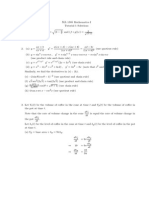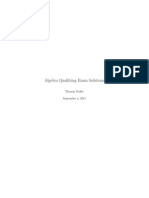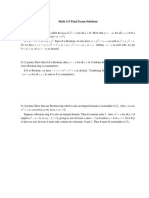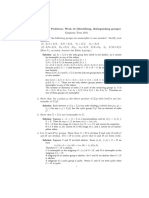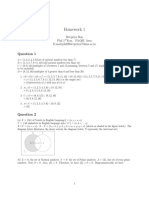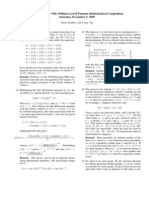Math 356 Abstract Algebra Midterm I (Due 5pm February 21st, 2003)
Math 356 Abstract Algebra Midterm I (Due 5pm February 21st, 2003)
Uploaded by
kvanps_kumarCopyright:
Available Formats
Math 356 Abstract Algebra Midterm I (Due 5pm February 21st, 2003)
Math 356 Abstract Algebra Midterm I (Due 5pm February 21st, 2003)
Uploaded by
kvanps_kumarOriginal Description:
Original Title
Copyright
Available Formats
Share this document
Did you find this document useful?
Is this content inappropriate?
Copyright:
Available Formats
Math 356 Abstract Algebra Midterm I (Due 5pm February 21st, 2003)
Math 356 Abstract Algebra Midterm I (Due 5pm February 21st, 2003)
Uploaded by
kvanps_kumarCopyright:
Available Formats
MATH 356 ABSTRACT ALGEBRA
Midterm I (due 5pm February 21st, 2003)
Instructions: This is a closed book, closed notes exam. Use of calculators is not permitted. You
have 3 hours. Show all your work for a full credit.
Print name :
Upon nishing please sign the pledge below:
On my honor I have neither given nor received any aid on this exam, and observed the time
limit specied above.
Signature :
Problem Max Points Your Score Problem Max Points Your Score
1 10 7 30
2 10 8 20
3 10 9 10
4 10 10 20
5 20 11 25
6 20 12 15
Total 200
1
2
(1) By using the multiplication table (cf. Table 1), show that there is only one (up
to isomorphism) group of order 3.
Table 1.
e a b
e
a
b
Solution. Clearly ab = e since if its a or b then it follows that b = e or a = e
respectively. Likewise, b a = e. We need to determine what a a and b b are.
a a cant be a since a ,= e. If a a = e then a a = a b and it follows that
a = b. Therefore a a = b. Likewise, b b = a.
(2) Show that R
, ) is not isomorphic to the circle group U = z C [ [z[ = 1 .
Solution. The two groups are not isomorphic in the same way C
, ) , R
, ),
which we have done in class. In short, the equation x
= 1 is solvable in the
former but not in the latter.
To be more concrete, suppose that there is an isomorphism
: U R
.
Since is a homomorphism, (1) = 1. Consider (1) : since ((1) (1)) =
(1) (1) = 1, so (1) is a square root of 1. It is not 1, since (1) = 1
and is one to one. Therefore (1) = 1.
Now consider (i). We have
1 = (1) = (i i) = (i) (i).
So (i) is a square root of -1 in R
!
(3) Construct an isomorphism between R/
2) and the circle group U.
Solution. Let : R U be dened by (x) = e
2ix/
2
. is onto, since for
any element e
i
o
U, we have
2
o
2
= e
i
o
. Now, lets compute the kernel
of . (x) = e
2ix/
2
= 1 if and only if x/
2 Z, that is x
2Z =
2).
Therefore R/
2) U.
(4) (a) Suppose that every proper subgroup of G is cyclic. Is G cyclic? If not,
give a counterexample.
3
Solution. Z
2
Z
2
is a counterexample.
(b) Suppose that every proper subgroup of G is abelian. Is G abelian? If not,
give a counterexample.
Solution. S
3
is a counterexample. Proper subgroups of S
3
have orders 1,
2, or 3. Hence they have to be abelian.
(5) Find all subgroups of D
3
, and draw a subgroup diagram.
Solution. D
3
= S
3
has one subgroup of order 3 consisting of rotations
1
) =
2
) =
0
,
1
,
2
. Since any rotation and a reection generate the whole D
3
,
there is no other subgroup of order 3. To nd subgroups of order 2, we note that
1
,
2
,
3
are the only elements of order 2. Therefore order 2 subgroups are
1
) =
0
,
1
,
2
) =
0
,
2
and
3
) =
0
,
3
. The subgroup diagram
of S
3
is as follows.
S
3
o
o
o
o
o
o
o
o
o
o
o
o
o
o
E
E
E
E
E
E
E
E
R
R
R
R
R
R
R
R
R
R
R
R
R
R
R
R
R
R
1
)
O
O
O
O
O
O
O
O
O
O
O
O
O
1
)
2
)
y
y
y
y
y
y
y
y
3
)
l
l
l
l
l
l
l
l
l
l
l
l
l
l
l
l
l
(6) Recall that an automorphism of a group G is a 1-1 onto homomorphism from
G to itself.
(a) How many automorphisms does Z/15Z have?
Solution. Generators of Z
15
are 1, 2, 4, 7, 8, 11, 13, 14. Hence it has 8
automorphisms.
(b) In general, how many automorphisms does Z/pqZ have for p and q distinct
prime numbers?
Solution. Number of automorphisms is equal to the number of positive
integers less than pq that are relatively prime to pq. We may assume p > q.
Multiples 1, p, 2p, . . . , (q1)p of p and multiples q, 2q, . . . , (p1)q of q
(less than pq) are the only nonzero elements that are not relatively prime
to pq. These two sets do not intersect : if mp = nq, then p divides n
4
but n p 1. Thus the number of elements that are not generators is
1 +(p 1) +(q 1). Hence the number of generators is pq 1 (p 1)
(q 1) = pq p (q 1) = (p 1)(q 1).
(7) Consider the following elements in S
6
.
=
1 2 3 4 5 6
4 2 6 5 1 3
, =
1 2 3 4 5 6
2 4 5 1 6 3
(a) Compute
2
and write it as a product of disjoint cycles, and then write
it as a product of transpositions.
Solution.
2
=
1 2 3 4 5 6
2 1 5 3 4 6
Thus
2
= (1 2)(3 5 4) = (1 2)(3 4)(3 5).
(b) List the orbits of
2
.
Solution. 1, 2, 3, 5, 4, 6.
(c) Compute the order [
2
)[.
Solution. (3 5 4) is of order 3 and (1 2) is of order 2 and they are disjoint.
Hence product of the 2 has order lcm(2, 3) = 6.
(8) Classify the following quotient groups according to the fundamental theorem
of nitely generated abelian groups.
(a) (Z/3Z Z/9Z)/(0, 2)).
Solution. (Z/3ZZ/9Z)/(0, 2)) Z/3Z(Z/9Z) /2) Z/3Z0 =
Z/3Z.
(b) (Z/3Z Z/9Z)/(2, 3)).
Solution. (2, 3)) is of order lcm(3, 3) = 3. Thus the quotient group
in question is of order
39
3
= 9. So it is either Z
9
or Z
3
Z
3
. Since
(2, 3)) = (2, 3), (1, 6), (0, 0), it is clear that 9 (0, 1) is the rst multiple
of (0, 1) that lands in (2, 3)). Hence (0, 1) +(2, 3)) is an element of order
9 in the quotient group. Hence it must be isomorphic to Z
9
.
5
(9) How many abelian groups (up to isomorphism) are there of order 120?
Solution. 120 = 2
3
3 5.
Z
8
Z
3
Z
5
Z
4
Z
2
Z
3
Z
5
Z
2
Z
2
Z
2
Z
3
Z
5
(10) Let be the homomorphism from Z Z Z to S
20
determined by
(1, 0, 0) = (1 4)(5 9 11 20)
(0, 1, 0) = (2 3 6)(7 13 18 19)
(0, 0, 1) = (8 10)(12 14 15)
(a) Compute (11, 26, 13).
Solution. (1, 0, 0) is of order lcm(2, 4) = 4, (0, 1, 0) is of order lcm(3, 4) =
12 and (0, 0, 1), of order lcm(2, 3) = 6. First we note that (0, 1, 0) =
(0, 1, 0)
1
= (6 3 2)(19 18 13 7).
(11, 26, 13) = (1, 0, 0)
11
(0, 1, 0)
26
(0, 0, 1)
13
= (1, 0, 0)
3
(0, 1, 0)
2
(0, 0, 1)
= (1 4)(20 11 9 5) (6 2 3)(19 13)(18 7) (8 10)(12 14 15).
(b) Compute Ker ().
Solution. Suppose that (a, b, c) = (1, 0, 0)
a
(0, 1, 0)
b
(0, 0, 1)
c
= e.
Since (1, 0, 0), (0, 1, 0), (0, 0, 1) are all disjoint, it must be that (1, 0, 0)
a
=
e,
(0, 1, 0)
b
= e, and (0, 0, 1)
c
= e. Therefore (a, b, c) = e if and only
if 4 [ a, 12 [ b and 6 [ c.
Ker () = 4Z 12Z 6Z.
(11) (a) Show that (Z Z) /(1, 2)) is isomorphic to Z.
Solution. The dening equation for the subgroup (1, 2)) is b = 2a. Let
: Z Z Z be dened by (a, b) = b 2a. This is a homomorphism
with kernel the subgroup dened by b = 2a, that is, (1, 2)). is onto,
hence (Z Z)/Ker () Z.
(b) Show that (Z Z) /(2, 4)) is not isomorphic to Z.
6
Solution. It has a torsion element (1, 2) (a torsion element is an element
of nite order), while Z doesnt have any. The quotient group in question
is isomorphic to Z Z
2
.
(c) Classify (Z Z Z) /(2, 2, 4)) according to the fundamental theorem of
nitely generated abelian groups.
Solution. The dening equation for the subgroup (2, 2, 4)) is
a 0 (mod 2)
b = a
c = 2a
Let : ZZZ Z
2
ZZ be the homomorphism dened by (a, b, c) =
(a, b a, c 2a). It is onto, and its kernel is determined by the three
equations above. Hence we have
(Z Z Z) /(2, 2, 4)) = (Z Z Z) /Ker () Z
2
Z Z.
(12) Let : Z
+
Z
+
be dened by (n) = s where s is the number of positive
integers less than or equal to n that are relatively prime to n. It is called the
Euler phi-fuction.
(a) Compute (5), (6), and (8).
Solution. (5) = 4, (6) = 2, (8) = 4.
(b) Note that (d) is equal to the number of generators for Z/dZ. Using this,
prove that
n =
d|n
(d).
Solution. Consider Z
n
and the fact that
n = [Z
n
[ =
|n
(number of elements of order d
)
But the elements of order d
are exactly the generators of d) where d =
n
d
.
Hence we have
n =
|n
(d) =
d|n
(d).
7
(c) Using (b), show that if x
m
= e has at most m solutions in a nite group
G for each positive integer m, then G is cyclic.
Solution. Let n = [G[. Again we have
n = [G[ =
d|n
(number of elements of order d)
by Lagranges theorem. Let g and h be elements of order d. Then elements
in g) and those in h) satisfy x
d
= e. Since x
d
= e has at most d solutions
by assumption and [g)[ = [h)[ = d, it follows that g) = h). Hence
if a is an element of order d, then it is an element of the subgroup g).
Therefore, the number of elements of order d does not exceed the number
of generators of g), which is (d). If there does not exist an element of
order n, then
n = [G[ =
d|n,d =n
(number of elements of order d)
d|n,d =n
(d) <
d|n
(d) = n
which is a contradiction. Therefore there must be an element of order n
in G. i.e. G must be cyclic.
You might also like
- Shiva Rea Thesis - Updated - 07Document50 pagesShiva Rea Thesis - Updated - 07Uwe Heim100% (1)
- Abstract Algebra (Beachy, Blair) 7.1 Problems and SolutionsDocument4 pagesAbstract Algebra (Beachy, Blair) 7.1 Problems and SolutionsC. Ephrem StuyvesantNo ratings yet
- 1 SolutionsDocument3 pages1 SolutionsMABIRIA BNo ratings yet
- MA1505 Tutorial Solution 1Document6 pagesMA1505 Tutorial Solution 1Bilguun BatboldNo ratings yet
- Express The Following As A Product of Disjoint Cycles, Then Compute Its Order.Document9 pagesExpress The Following As A Product of Disjoint Cycles, Then Compute Its Order.Nehal AnuragNo ratings yet
- XVCNDocument22 pagesXVCNMuthumanikandan HariramanNo ratings yet
- Algebra Practice Problems Hints and SolutionsDocument4 pagesAlgebra Practice Problems Hints and Solutionsotnaira idulNo ratings yet
- Rutgers University Graduate Program in MathematicsDocument13 pagesRutgers University Graduate Program in MathematicsMohan RaoNo ratings yet
- Fall 2013 PDFDocument10 pagesFall 2013 PDFlopezmegoNo ratings yet
- Solution Outlines For Chapter 10Document4 pagesSolution Outlines For Chapter 10Dawna AkonaNo ratings yet
- MAT 444 Instructor: Helene Barcelo May 6, 2004 Final Exam: N Be The Number of Sylow P PDocument6 pagesMAT 444 Instructor: Helene Barcelo May 6, 2004 Final Exam: N Be The Number of Sylow P Ptrue_kanjiNo ratings yet
- LAL Lecture NotesDocument73 pagesLAL Lecture NotesAnushka VijayNo ratings yet
- Algebra Qualifying Exam SolutionsDocument26 pagesAlgebra Qualifying Exam SolutionsViktor HanNo ratings yet
- Algebra (Dummit) HW 1Document15 pagesAlgebra (Dummit) HW 1homanho2021No ratings yet
- Math 113 Final SolDocument8 pagesMath 113 Final SolMartin BandaNo ratings yet
- ProblemsDocument4 pagesProblemsRoshidul IslamNo ratings yet
- (a+bi) + (c+ di) = (a+c) + (b+d) i = (a+ c) − (b+ d) i= (a−bi) + (c−di) =φ (a+bi) +φ (c+ di)Document7 pages(a+bi) + (c+ di) = (a+c) + (b+d) i = (a+ c) − (b+ d) i= (a−bi) + (c−di) =φ (a+bi) +φ (c+ di)kenneth mendozaNo ratings yet
- Homework #4 Solutions (Due 10/3/06) : Niversity of Ennsylvania Epartment of AthematicsDocument5 pagesHomework #4 Solutions (Due 10/3/06) : Niversity of Ennsylvania Epartment of Athematicsbond12314No ratings yet
- Mat1341 TT2 2010WDocument4 pagesMat1341 TT2 2010WexamkillerNo ratings yet
- Masters Examination in MathematicsDocument10 pagesMasters Examination in MathematicstonynuganNo ratings yet
- Topics in Algebra Solution: Sung Jong Lee, Lovekrand - Github.io December 8, 2020Document16 pagesTopics in Algebra Solution: Sung Jong Lee, Lovekrand - Github.io December 8, 2020hGanieetNo ratings yet
- Mat313 fall2013PFinalDocument9 pagesMat313 fall2013PFinalLaysa PalomarNo ratings yet
- Selected Problems from Marcus, Number Fields: 2πi/m th thDocument4 pagesSelected Problems from Marcus, Number Fields: 2πi/m th thEpic WinNo ratings yet
- Clay ShonkwilerDocument7 pagesClay ShonkwilerPeter HuNo ratings yet
- Alg20 Hw15 SolDocument3 pagesAlg20 Hw15 SolM JavedNo ratings yet
- Math185f09 Hw10solDocument7 pagesMath185f09 Hw10solJose Luis CondoriNo ratings yet
- SF2729 Groups and Rings Final Exam Solutions: Solution ( )Document3 pagesSF2729 Groups and Rings Final Exam Solutions: Solution ( )Andy OrtizNo ratings yet
- Extra Questions For Exam Review - AnswersDocument3 pagesExtra Questions For Exam Review - AnswersAndy KhongNo ratings yet
- Algebra 2Document6 pagesAlgebra 2Miliyon TilahunNo ratings yet
- Abstract Algebra HarvardDocument276 pagesAbstract Algebra HarvardProfesseur AbdelhakNo ratings yet
- MIT Multivariable Calculus Exam A SolutionsDocument16 pagesMIT Multivariable Calculus Exam A Solutions15klaNo ratings yet
- Number Theory 2Document8 pagesNumber Theory 2Soumabha NandiNo ratings yet
- Dedicated To Professor Dr. Ioan A. Rus On His 70th BirthdayDocument17 pagesDedicated To Professor Dr. Ioan A. Rus On His 70th Birthdayfahri_amirullahNo ratings yet
- Discussion 12 Fall 2019 SolutionsDocument8 pagesDiscussion 12 Fall 2019 SolutionssamNo ratings yet
- Homework Solution 3Document7 pagesHomework Solution 3Saad Malik100% (1)
- Asg1 SolnDocument4 pagesAsg1 SolnVishvesh PatelNo ratings yet
- MATH30300: Group Theory Homework 4: SolutionsDocument4 pagesMATH30300: Group Theory Homework 4: SolutionsKetul ModiNo ratings yet
- Periodical Plane Puzzles With NumbersDocument33 pagesPeriodical Plane Puzzles With NumbersbalbasaurNo ratings yet
- 175 Fall2009 Final SolDocument6 pages175 Fall2009 Final Solnurullah_bulutNo ratings yet
- CHAPTER 8 The Complex NumbersDocument12 pagesCHAPTER 8 The Complex NumbersdaisyabonitaNo ratings yet
- Homework 9 SolutionDocument3 pagesHomework 9 SolutionFilip MajstorovićNo ratings yet
- Math 120: Homework 4 Solutions: October 26, 2018Document5 pagesMath 120: Homework 4 Solutions: October 26, 2018Ngô Thị Thu HiềnNo ratings yet
- S 1 SolDocument4 pagesS 1 SolEric ParkerNo ratings yet
- Practice Final1 EE235Document9 pagesPractice Final1 EE235Phan Phuong NgocNo ratings yet
- Generator of Group of Order 60Document5 pagesGenerator of Group of Order 60Houessou BernardinNo ratings yet
- Homomorphism ANSWERSDocument4 pagesHomomorphism ANSWERSFIRJON NURISNA HADI AL HAQNo ratings yet
- Midterm Complex AnalysisDocument16 pagesMidterm Complex AnalysisjhjoannaNo ratings yet
- Course 424 Group Representations: DR Timothy Murphy Sample PaperDocument31 pagesCourse 424 Group Representations: DR Timothy Murphy Sample Paper2eaa889cNo ratings yet
- Homework 7 SolutionsDocument5 pagesHomework 7 SolutionsKANTHAVEL TNo ratings yet
- 4720 Quiz Abstract AlgebraDocument13 pages4720 Quiz Abstract AlgebralocalwayNo ratings yet
- Math 121 HW 2Document6 pagesMath 121 HW 2Abdul TambunanNo ratings yet
- Homework 2 Solutions: Joe Neeman September 22, 2010Document8 pagesHomework 2 Solutions: Joe Neeman September 22, 2010ShuX13No ratings yet
- Mathematics AssignmentDocument5 pagesMathematics AssignmentBadd ManNo ratings yet
- C C C C CDocument7 pagesC C C C Cfree_progNo ratings yet
- Homework Solution 2Document5 pagesHomework Solution 2Saad MalikNo ratings yet
- Putnam 2009 SolutionsDocument5 pagesPutnam 2009 SolutionsWilliam MaxwellNo ratings yet
- Math 108 LE2 Samplex SolutionsDocument5 pagesMath 108 LE2 Samplex SolutionsSamuel SalacupNo ratings yet
- MathsDocument3 pagesMathsmohanNo ratings yet
- Public Algo Authentication EtcDocument44 pagesPublic Algo Authentication EtcgeetanjaliNo ratings yet
- Math 3005 Final Solution: Fall 2014 - MoonDocument6 pagesMath 3005 Final Solution: Fall 2014 - Moontt_aljobory3911No ratings yet
- Trigonometric Ratios to Transformations (Trigonometry) Mathematics E-Book For Public ExamsFrom EverandTrigonometric Ratios to Transformations (Trigonometry) Mathematics E-Book For Public ExamsRating: 5 out of 5 stars5/5 (1)
- Specialty HeatersDocument40 pagesSpecialty Heaterskvanps_kumarNo ratings yet
- PHD Physics EntranceDocument18 pagesPHD Physics Entrancekvanps_kumarNo ratings yet
- The Physics of Quadrupole Mass SpectrometryDocument16 pagesThe Physics of Quadrupole Mass Spectrometrykvanps_kumarNo ratings yet
- Opportunites After 10+2Document11 pagesOpportunites After 10+2kvanps_kumarNo ratings yet
- MSC PhysicsDocument20 pagesMSC Physicskvanps_kumar100% (1)
- PHD Physics EntranceDocument18 pagesPHD Physics Entrancekvanps_kumarNo ratings yet
- Palanquin Bearers PoemDocument4 pagesPalanquin Bearers Poemkvanps_kumar100% (1)
- Ch. 28 Magnetic Field: Text: Fundamentals of Physics (8 Ed.) by Halliday, Resnick, WalkerDocument27 pagesCh. 28 Magnetic Field: Text: Fundamentals of Physics (8 Ed.) by Halliday, Resnick, Walkerkvanps_kumarNo ratings yet
- Magnet Guide & Tutorial: For More Information Please ContactDocument38 pagesMagnet Guide & Tutorial: For More Information Please ContactRiadh TarkhaniNo ratings yet
- Lehi's Tree of LifeDocument5 pagesLehi's Tree of LifeAnthony E. LarsonNo ratings yet
- Semantics and Pragmatics - Final Test 2019 PDFDocument7 pagesSemantics and Pragmatics - Final Test 2019 PDFNari WulandariNo ratings yet
- Letter To God Q:Ans PDFDocument6 pagesLetter To God Q:Ans PDFArnav SinghalNo ratings yet
- Change Management-An Unending Micro and Macro Minuet: Mariela K. Farhi-ZimmermanDocument11 pagesChange Management-An Unending Micro and Macro Minuet: Mariela K. Farhi-ZimmermanChinmayJoshiNo ratings yet
- English SPMDocument157 pagesEnglish SPMNajwa Abu Samah75% (4)
- Ap201011 PDFDocument88 pagesAp201011 PDFArunimaHarshanNo ratings yet
- KnjigaDocument12 pagesKnjigaPop-Mitic DarinkaNo ratings yet
- Chapter 1 Basic Concepts of CommunicationDocument46 pagesChapter 1 Basic Concepts of CommunicationNahum Dave MancillaNo ratings yet
- L1 Obtain and Convey Workplace InformationDocument37 pagesL1 Obtain and Convey Workplace InformationNarciso CardanaNo ratings yet
- Thesis YelDocument20 pagesThesis YelJasmin EstabilloNo ratings yet
- L. Psalm 119.89-96 PDFDocument7 pagesL. Psalm 119.89-96 PDFpacurarNo ratings yet
- Micro TeachingDocument17 pagesMicro Teachinggeetkumar18No ratings yet
- CHED's FrameworkDocument15 pagesCHED's FrameworkJune BarsNo ratings yet
- Scamming Lit ReviewDocument33 pagesScamming Lit ReviewLoco Moco100% (1)
- McKinsey and Company-Kowledge ManagementDocument8 pagesMcKinsey and Company-Kowledge ManagementBrago Ajp100% (1)
- Great Political ThinkersDocument2 pagesGreat Political ThinkersgerardobarrioNo ratings yet
- MondialisationDocument4 pagesMondialisation33s11No ratings yet
- Farwell Brain Fingerprinting Corrections To Rosenfeld Scientific Review of Mental Health PracticeDocument14 pagesFarwell Brain Fingerprinting Corrections To Rosenfeld Scientific Review of Mental Health PracticeVikas GuptaNo ratings yet
- Emic and Etic Study GuideDocument2 pagesEmic and Etic Study Guideapi-24930641650% (2)
- 2 Terms and DefinitionsDocument21 pages2 Terms and DefinitionsGabrielaNo ratings yet
- The Ugly Truth About Milton Friedman - Nancy SpannausDocument2 pagesThe Ugly Truth About Milton Friedman - Nancy SpannausElder Futhark100% (1)
- L/L Research: Saturday MeditationDocument6 pagesL/L Research: Saturday Meditationsoul777No ratings yet
- Martyrdom HistoriographyDocument11 pagesMartyrdom HistoriographyNunzio N. D'AlessioNo ratings yet
- What Is WritingDocument78 pagesWhat Is Writingsofyanah sifa100% (1)
- A Stylistic Study of ParallelismDocument130 pagesA Stylistic Study of ParallelismSawsan Alsaaidi100% (1)
- Landmark Newsletter: Creating The Life You Really WantDocument3 pagesLandmark Newsletter: Creating The Life You Really Wantolivkazolivek0% (1)
- Mark 1:9-11 - BAPTISM OF THE SERVANTDocument8 pagesMark 1:9-11 - BAPTISM OF THE SERVANTCalvary Tengah Bible-Presbyterian ChurchNo ratings yet
- Bài mẫu 3Document37 pagesBài mẫu 3Trâm NgọcNo ratings yet
- Writing A Summary in 6 Simple Steps Teacher Nuha S English Blog PDFDocument6 pagesWriting A Summary in 6 Simple Steps Teacher Nuha S English Blog PDFSMK Raja lumu Bidang BahasaNo ratings yet



